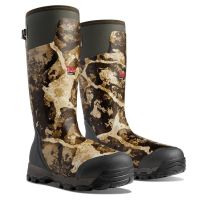
Late season hunts pose a unique set of challenges, the most apparent of which is staying warm. This is especially true for whitetail hunts when you’ll be sitting nearly motionless for hours on end, generating little to no excess body heat. To combat the cold and make the hunt an enjoyable experience, give these gear hacks a try.
Insulated Tree Stand Platform Cold feet are probably the number one culprit for cutting a hunt short. To last longer in the stand, I’ve come across a gear hack that is extremely effective at reducing the amount of heat you’ll lose through conductive heat transfer from your feet to that ice-cold tree stand platform. The trick is to pack along an insulating material to place between your boots and the metal platform. Any foam pad will work, but I’ve had good luck with lightweight foam camping pads. Be aware that some of these pads can be squeaky, so pick one that will remain quiet under rubber boots.
Functional Bow Hanger We all know how cold an aluminum bow riser can be during late season. I am continually surprised by how many experienced bowhunters I see that keep their bow on their lap throughout the entire hunt. Over the course of the hunt, that highly conductive bow riser is sure to chill your lap, right down to the bone. It seems obvious, but the easiest remedy is to pack an extendable bow hanger. I like the Hawk Xtendible Tree Arm, which is light enough to pack in with me on every hunt. It also has the ability to pivot and dangle the bow right in front of you, allowing you to grab your bow quickly and with minimal excess movement.
Hot Snacks Straight from the king of #nevergosnackless, Sam Soholt is a whitetail killer and no stranger to long, cold sits on public dirt. “These days, there are endless options for vacuum insulated beverage vessels,” Soholt said. “Pick your favorite. Mine is a 26-ounce Yeti bottle with a chug cap. Fill it with coffee, hot chocolate, tea, even just warm water to sip on throughout the sit. This will help warm up your core and keep the rest of your body warm as well.”
Soholt is a firm believer that snacks are key to sitting out cold days, and there’s not need to stick to granola bars and trail mix. “Cold weather combined with an empty stomach is a recipe for weak mental state, especially if the deer are not moving much. You can always go with the old classics: jerky, cookies, candy, etc., but I prefer something a little heartier,” Sohold said. “A Yeti bottle can also be used for warm food. Pizza rolls, gravy, apple pie, breakfast scramble, burrito, etc. can all be kept warm for hours in a Yeti bottle.”
Clothing Strategy When the temps dip into the single digits I like to throw a down vest into my layering system. While it may be unconventional whitetail attire, down is about as warm as it gets, and a sleeveless vest will be plenty quiet under your dedicated whitetail jacket.
Often the crux of staying warm is staying dry. Getting all sweated up on the commute to your tree stand, paired with a poor, low breathability, and a slow-drying base layer is a recipe for disaster. On your walk to the stand, fight the temptation to wear your whole kit, instead wear only wool base layers and minimal outer layers.
“It’s hard not to just keep adding layer upon layer to try and stay warm, but you need to understand that there needs to be a little room for your outer layers to trap that warm air next to your body,” Soholt said. “I always run merino base layers, then a mid weight, then an insulator, then my shell/outer layer. I don't want any of those layers to be too tight. This allows my body heat to properly warm up all of my layers.”
Soholt is also a big fan of HotHands. “I crack open six to ten of those bad boys depending on the temp outside. I break them open before I leave the truck and throw them all in my hand muff,” Soholt said. “Once I'm in the tree, I'll spread them out a bit into interior pockets to help keep my core warm and keep the bulk of them in my muff to keep my hands warm. I’ve found that as long as my fingers stay warm, I can stay in the game mentally for longer in low temps.”
Sock Strategy Just like wet base layers, wet socks equal cold feet. Picking the right sock is just as important as picking the right boot for cold weather hunts. If you struggle with wet feet, try using a liner sock to promote breathability. For those unfamiliar, a liner sock is a very thin sock designed to be breathable and worn under a more substantial outer sock.
The second tip is to pony up and buy new socks for the rut. A new pair of lofty socks that haven’t been compacted after hard use are going to be much warmer than your old crusty hiking sock. For the coldest hunts in swampy rubber boots, sometimes I’ll even pack a second pair of dry socks and put them on once I reach the stand.
Feature image via Captured Creative.





